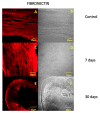Human Dental Pulp Tissue during Orthodontic Tooth Movement: An Immunofluorescence Study
- PMID: 33467280
- PMCID: PMC7739291
- DOI: 10.3390/jfmk5030065
Human Dental Pulp Tissue during Orthodontic Tooth Movement: An Immunofluorescence Study
Abstract
The orthodontic tooth movement is the last step of several biological processes that take place after the application of external forces. During this process, dental pulp tissue is subjected to structural and protein expression modifications in order to maintain their integrity and functional morphology. The purpose of the present work was to perform an in vivo study, evaluating protein expression modifications in the human dental pulp of patients that have undergone orthodontic tooth movement due to pre-calibrated light force application for 30 days. Dental pulp samples were extracted from molars and premolars of the control group and after 7 and 30 days of treatment; the samples were then processed for immunofluorescence reactions using antibodies against fibronectin, collagen I and vascular endothelial growth factor (VEGF). Our results show that, after 7 days of treatment, all tested proteins change their pattern expression and will reset after 30 days. These data demonstrate that the dental pulp does not involve any irreversible iatrogenic alterations, supporting the efficacy and safety of using pre-calibrated force application to induce orthodontic tooth movement in clinical practice.
Keywords: extracellular matrix proteins; human dental pulp; immunofluorescence; orthodontic tooth movement.
Conflict of interest statement
The Authors declare no conflict of interest.
Figures






Similar articles
-
An immunofluorescence study on VEGF and extracellular matrix proteins in human periodontal ligament during tooth movement.Heliyon. 2019 Oct 4;5(10):e02572. doi: 10.1016/j.heliyon.2019.e02572. eCollection 2019 Oct. Heliyon. 2019. PMID: 31667410 Free PMC article.
-
Expression and Function of Hypoxia Inducible Factor-1α and Vascular Endothelial Growth Factor in Pulp Tissue of Teeth under Orthodontic Movement.Mediators Inflamm. 2015;2015:215761. doi: 10.1155/2015/215761. Epub 2015 Sep 9. Mediators Inflamm. 2015. PMID: 26441483 Free PMC article.
-
Application of pulp tissue genetic profile in orthodontic tooth movement: a needle in a haystack?Evid Based Dent. 2025 Mar;26(1):61-62. doi: 10.1038/s41432-025-01131-w. Epub 2025 Mar 3. Evid Based Dent. 2025. PMID: 40033024
-
Endodontic-orthodontic relationships: a review of integrated treatment planning challenges.Int Endod J. 1999 Sep;32(5):343-60. doi: 10.1046/j.1365-2591.1999.00252.x. Int Endod J. 1999. PMID: 10551108 Review.
-
Pulp Changes Secondary to Orthodontic Forces: A Review of Literature.Cureus. 2023 Jun 17;15(6):e40573. doi: 10.7759/cureus.40573. eCollection 2023 Jun. Cureus. 2023. PMID: 37465810 Free PMC article. Review.
Cited by
-
Five Numerical Methods to Assess the Ischemic Risks in Dental Pulp and Neuro-Vascular Bundle Under Orthodontic Movements in Intact Periodontium In Vitro.Dent J (Basel). 2024 Dec 27;13(1):15. doi: 10.3390/dj13010015. Dent J (Basel). 2024. PMID: 39851591 Free PMC article.
-
Articular Disc of a Human Temporomandibular Joint: Evaluation through Light Microscopy, Immunofluorescence and Scanning Electron Microscopy.J Funct Morphol Kinesiol. 2021 Feb 25;6(1):22. doi: 10.3390/jfmk6010022. J Funct Morphol Kinesiol. 2021. PMID: 33669061 Free PMC article.
-
Periodontal Breakdown, Orthodontic Movements and Pulpal Ischemia Correlations-A Comparison Between Five Study Methods.J Clin Med. 2024 Nov 22;13(23):7062. doi: 10.3390/jcm13237062. J Clin Med. 2024. PMID: 39685521 Free PMC article.
-
Assessment of the Maximum Amount of Orthodontic Force for Dental Pulp and Apical Neuro-Vascular Bundle in Intact and Reduced Periodontium on Bicuspids (Part II).Int J Environ Res Public Health. 2023 Jan 9;20(2):1179. doi: 10.3390/ijerph20021179. Int J Environ Res Public Health. 2023. PMID: 36673936 Free PMC article.
-
Histological and Immunohistochemical Insights into Disc Perforation in the Temporomandibular Joint: A Case Report.J Funct Morphol Kinesiol. 2025 Mar 27;10(2):107. doi: 10.3390/jfmk10020107. J Funct Morphol Kinesiol. 2025. PMID: 40566404 Free PMC article.
References
-
- Anastasi G., Cordasco G., Matarese G., Nucera R., Rizzo G., Mazza M., Militi A., Portelli M., Cutroneo G., Favaloro A. An immunohistochemical, histological, and electron-microscopic study of the human periodontal ligament during orthodontic treatment. Int. J. Mol. Med. 2008;21:545–554. doi: 10.3892/ijmm.21.5.545. - DOI - PubMed
-
- Militi A., Cutroneo G., Favaloro A., Matarese G., Di Mauro D., Lauritano F., Centofanti A., Cervino G., Nicita F., Bramanti A., et al. An Immunofluorescence Study on VEGF and Extracellular Matrix Proteins in Human Periodontal Ligament during Tooth Movement. Heliyon. 2019;5:e02572. doi: 10.1016/j.heliyon.2019.e02572. - DOI - PMC - PubMed
-
- Cutroneo G., Centofanti A., Speciale F., Rizzo G., Favaloro A., Santoro G., Bruschetta D., Milardi D., Micali A., Di Mauro D., et al. Sarcoglycan Complex in Masseter and Sternocleidomastoid Muscles of Baboons: An Immunohistochemical Study. Eur. J. Histochem. 2015;59:2509. doi: 10.4081/ejh.2015.2509. - DOI - PMC - PubMed
-
- Cutroneo G., Vermiglio G., Centofanti A., Rizzo G., Runci M., Favaloro A., Piancino M.G., Bracco P., Ramieri G., Bianchi F., et al. Morphofunctional Compensation of Masseter Muscles in Unilateral Posterior Crossbite Patients. Eur. J. Histochem. 2016;60:2605. doi: 10.4081/ejh.2016.2605. - DOI - PMC - PubMed
LinkOut - more resources
Full Text Sources

